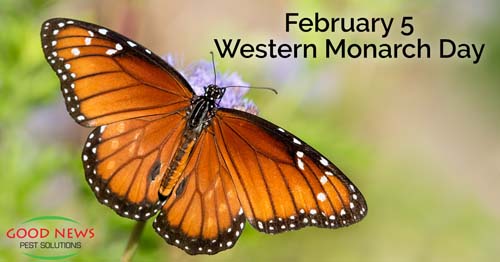
Western Monarch Day is February 5th!
Most of us are familiar with birds that migrate North when the weather warms up and that return our way in the late summer and fall as the northern temperatures drop.
But did you know that the Monarch Butterfly also migrates with the seasons? And it’s a lot harder on them than it is on our feathered friends.
Small Beginnings
Like most butterflies, this most familiar and recognizable species starts as a caterpillar. Hibernating butterflies emerge in February and early March, mate and lay eggs. Newly laid eggs hatch in about 4-5 days, and the caterpillars that emerge feed on milkweed plants for about two weeks, then spin a cocoon around themselves.
In another two weeks, the Danaus plexippus, emerge from their chrysalises and the cycle starts over. These new butterflies will live for two to six weeks, where they will mate and lay eggs to start the process again.
The second generation of Monarch Butterflies hatches in May and June. And it takes four whole generations of butterflies to live through a year and the migration process. The fourth generation heads to warmer climes and lives for six to eight months before returning.
A King’s Greeting
The first week of February is traditionally when folks in California welcome the Monarch Butterflies. This year, the official day is February 5th, and at five different sites across the state, people gather to see more than 10,000 butterflies launching to pollinate.
More attention has been given to Western Monarch Day in the past few years, as numbers of these wondrous beauties have dwindled. Although it seemed like more Monarchs that had been seen in years took flight last year, experts say the numbers have dropped since 1990.
Only about 10% of the Monarch Butterfly population numbers recorded in the 80’s are still around. A 3-day freeze in Mexico in 1991 cost a large percentage of wintering butterflies that year, and we’re still not recovered. Pesticides and genetically modified plants are also affecting the Monarch numbers.
The Royal Preservation
The good news is that volunteer organizations like Monarch Watch and the Xerces Society work tirelessly to monitor the butterfly populations, map milkweed patches and educate the public on the diminishing numbers of these able pollinators.
Since 2002, Live Monarch has offered milkweed seeds and live plants for pennies to concerned citizens who want to plant their own Monarch-friendly garden areas. This year, they relocated to a new area and are building a greenhouse, so only seeds are available. But just $3.50 gets you 150 seeds and instructions sheets on how to best use them. Many groups get large quantities and plant milkweed fields as school or church projects.
Consider planting your own milkweed patch in your backyard, to attract the prettiest of butterflies to your home. For the past 30 years, Good News Pest Solutions has been committed to using the most risk-reduced pest control solutions – safe for your family, your pets, and yes, the butterflies. Call us to find out more about our commitment to going green and stewarding the earth, and to schedule an appointment for one of our highly trained technicians to service your home, today!
« Back to BlogProudly Serving
Sun City Center, Ruskin, Palmetto, Parrish, Ellenton, Bradenton, Anna Maria, Holmes Beach, Bradenton Beach, Longboat Key, Lakewood Ranch, University Park, Myakka City, Sarasota, Siesta Key, Osprey, Nokomis, Casey Key, Venice, Englewood, North Port, Port Charlotte, Punta Gorda, Arcadia
Things You Can Do
Pay Your Bill Online
Leave Us a Review
Request a Free* Termite Inspection
Stop Mosquito Bites
Get Rid of Rodents
Get a Termite Damage Warranty
Get Pest Control for Your Attic
Get Pest Control for Your Business Request Prayer
Corporate Address
1080 Enterprise Court, Ste A
North Venice, FL 34275
Call Now: (941) 412-9610
Text: (941) 412-9610
Fax: (941) 412-0080
